A Comprehensive Analysis of Mise-en-Scene in The Conjuring Movie
VerifiedAdded on 2020/01/23
|6
|1458
|1139
Essay
AI Summary
This essay provides an in-depth analysis of the supernatural horror film 'The Conjuring,' focusing on the effective use of mise-en-scene to create a terrifying atmosphere. The essay explores how the film utilizes stage design, cinematography, and artful direction to influence the audience's perception of the events. It details the narrative style, which employs flashbacks and parallel timelines to build suspense. The essay meticulously examines the use of camera techniques, including unnatural angles, shaky movements, close-up shots, and Dutch tilts, as well as editing, lighting, and sound design to enhance the film's impact. A shot-by-shot analysis further illustrates how specific scenes, such as the close-up of the doll and the use of steady cam effects, contribute to the overall horror experience. The essay highlights how elements like darkness, drab colors, and sound effects are strategically employed to create fear and suspense, ultimately making 'The Conjuring' a compelling example of effective filmmaking techniques.
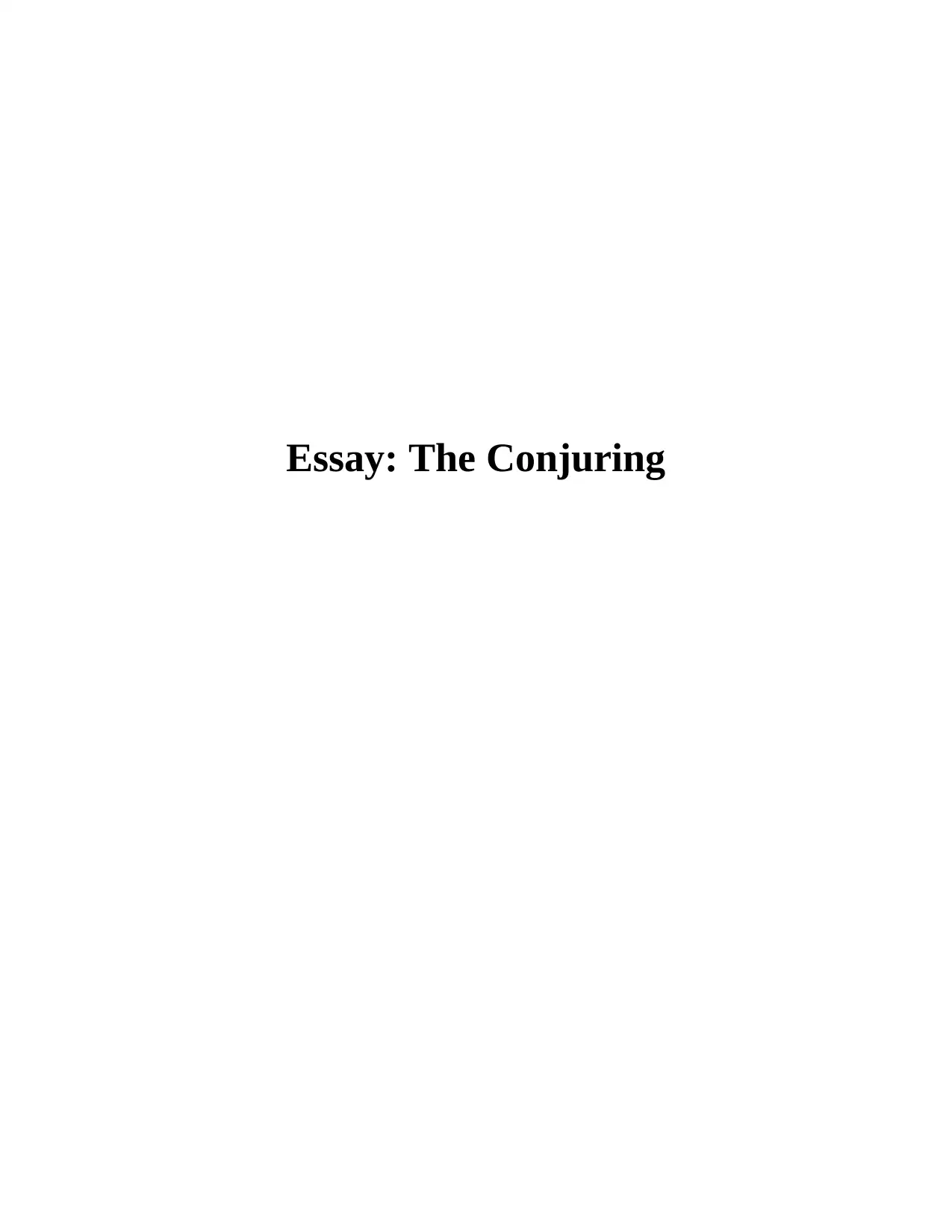
Essay: The Conjuring
Paraphrase This Document
Need a fresh take? Get an instant paraphrase of this document with our AI Paraphraser
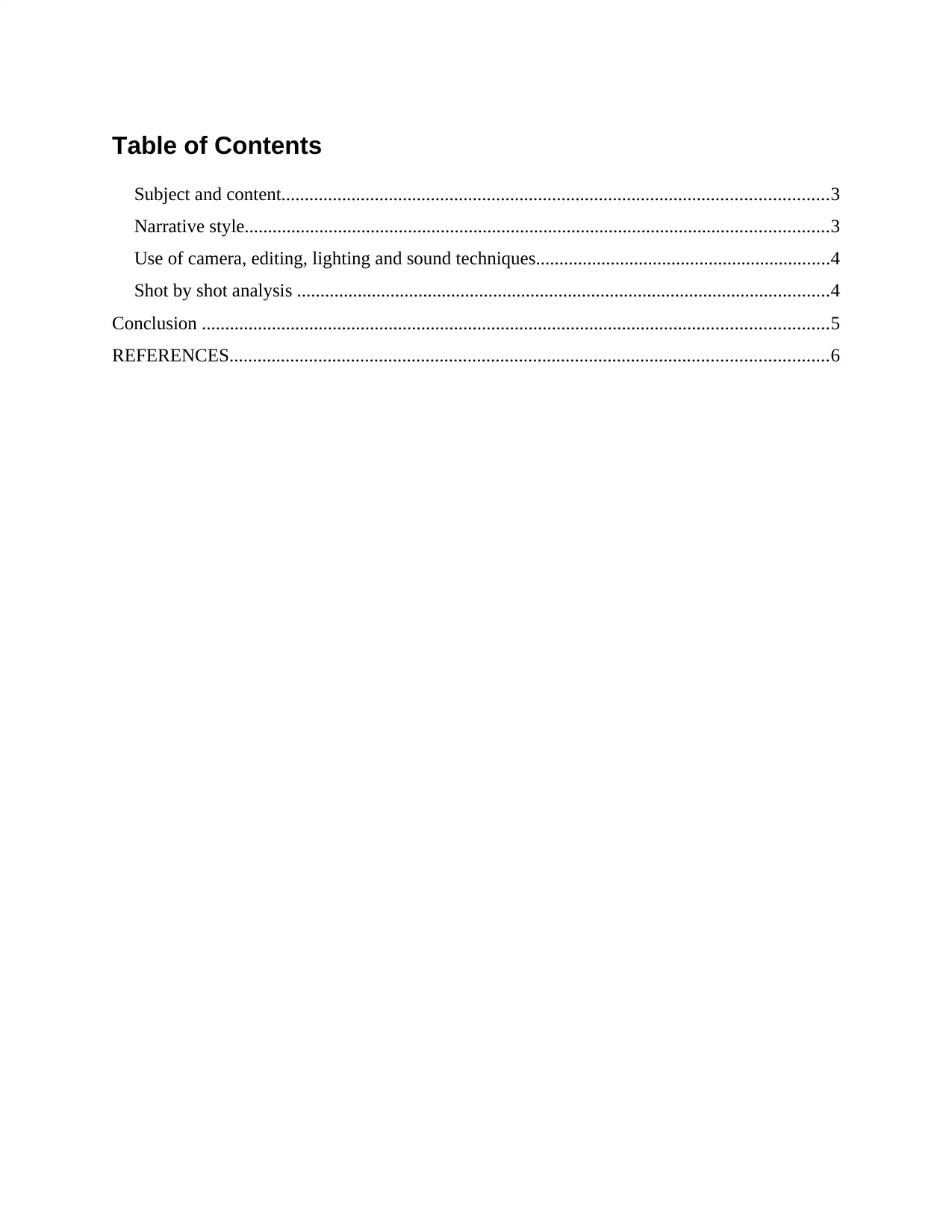
Table of Contents
Subject and content.....................................................................................................................3
Narrative style.............................................................................................................................3
Use of camera, editing, lighting and sound techniques...............................................................4
Shot by shot analysis ..................................................................................................................4
Conclusion ......................................................................................................................................5
REFERENCES................................................................................................................................6
Subject and content.....................................................................................................................3
Narrative style.............................................................................................................................3
Use of camera, editing, lighting and sound techniques...............................................................4
Shot by shot analysis ..................................................................................................................4
Conclusion ......................................................................................................................................5
REFERENCES................................................................................................................................6
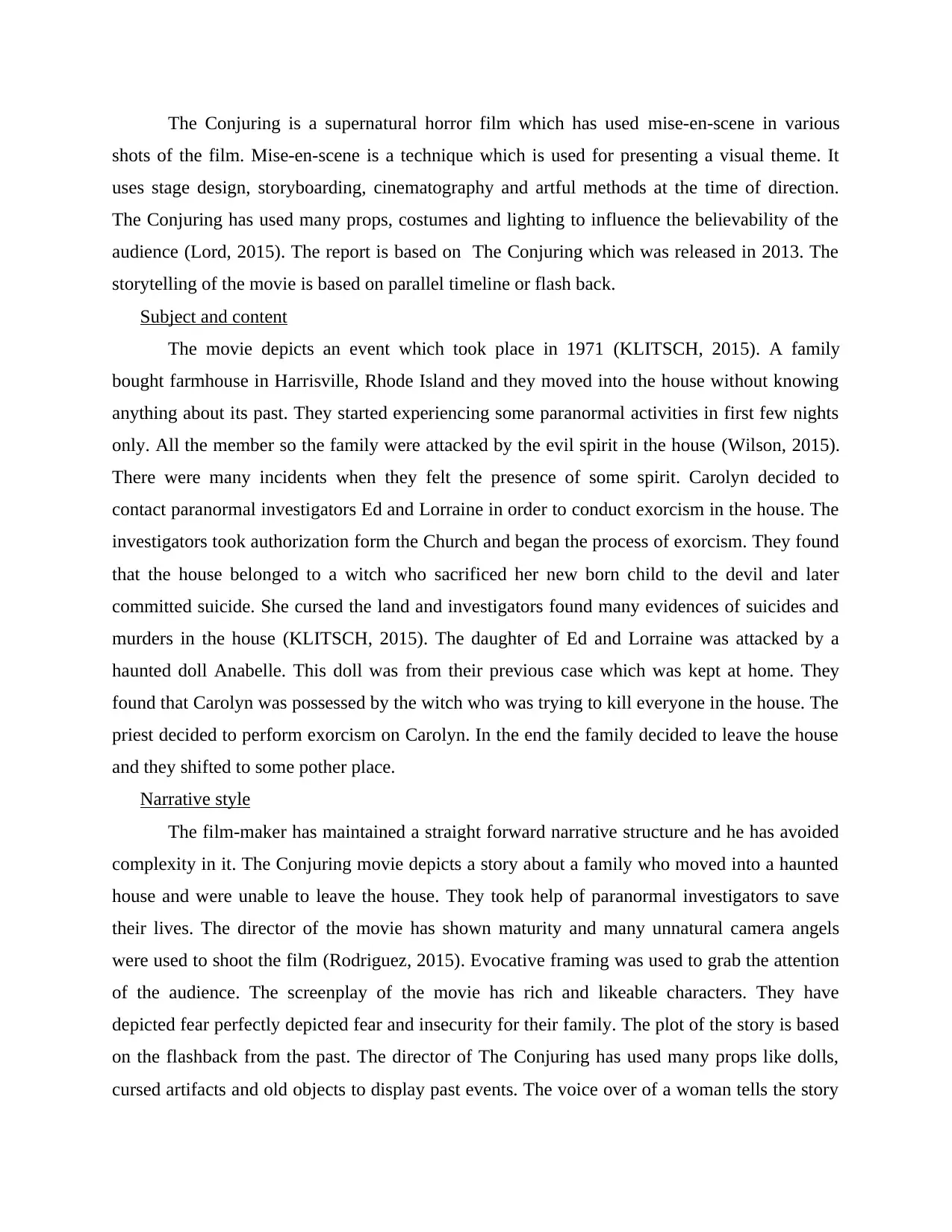
The Conjuring is a supernatural horror film which has used mise-en-scene in various
shots of the film. Mise-en-scene is a technique which is used for presenting a visual theme. It
uses stage design, storyboarding, cinematography and artful methods at the time of direction.
The Conjuring has used many props, costumes and lighting to influence the believability of the
audience (Lord, 2015). The report is based on The Conjuring which was released in 2013. The
storytelling of the movie is based on parallel timeline or flash back.
Subject and content
The movie depicts an event which took place in 1971 (KLITSCH, 2015). A family
bought farmhouse in Harrisville, Rhode Island and they moved into the house without knowing
anything about its past. They started experiencing some paranormal activities in first few nights
only. All the member so the family were attacked by the evil spirit in the house (Wilson, 2015).
There were many incidents when they felt the presence of some spirit. Carolyn decided to
contact paranormal investigators Ed and Lorraine in order to conduct exorcism in the house. The
investigators took authorization form the Church and began the process of exorcism. They found
that the house belonged to a witch who sacrificed her new born child to the devil and later
committed suicide. She cursed the land and investigators found many evidences of suicides and
murders in the house (KLITSCH, 2015). The daughter of Ed and Lorraine was attacked by a
haunted doll Anabelle. This doll was from their previous case which was kept at home. They
found that Carolyn was possessed by the witch who was trying to kill everyone in the house. The
priest decided to perform exorcism on Carolyn. In the end the family decided to leave the house
and they shifted to some pother place.
Narrative style
The film-maker has maintained a straight forward narrative structure and he has avoided
complexity in it. The Conjuring movie depicts a story about a family who moved into a haunted
house and were unable to leave the house. They took help of paranormal investigators to save
their lives. The director of the movie has shown maturity and many unnatural camera angels
were used to shoot the film (Rodriguez, 2015). Evocative framing was used to grab the attention
of the audience. The screenplay of the movie has rich and likeable characters. They have
depicted fear perfectly depicted fear and insecurity for their family. The plot of the story is based
on the flashback from the past. The director of The Conjuring has used many props like dolls,
cursed artifacts and old objects to display past events. The voice over of a woman tells the story
shots of the film. Mise-en-scene is a technique which is used for presenting a visual theme. It
uses stage design, storyboarding, cinematography and artful methods at the time of direction.
The Conjuring has used many props, costumes and lighting to influence the believability of the
audience (Lord, 2015). The report is based on The Conjuring which was released in 2013. The
storytelling of the movie is based on parallel timeline or flash back.
Subject and content
The movie depicts an event which took place in 1971 (KLITSCH, 2015). A family
bought farmhouse in Harrisville, Rhode Island and they moved into the house without knowing
anything about its past. They started experiencing some paranormal activities in first few nights
only. All the member so the family were attacked by the evil spirit in the house (Wilson, 2015).
There were many incidents when they felt the presence of some spirit. Carolyn decided to
contact paranormal investigators Ed and Lorraine in order to conduct exorcism in the house. The
investigators took authorization form the Church and began the process of exorcism. They found
that the house belonged to a witch who sacrificed her new born child to the devil and later
committed suicide. She cursed the land and investigators found many evidences of suicides and
murders in the house (KLITSCH, 2015). The daughter of Ed and Lorraine was attacked by a
haunted doll Anabelle. This doll was from their previous case which was kept at home. They
found that Carolyn was possessed by the witch who was trying to kill everyone in the house. The
priest decided to perform exorcism on Carolyn. In the end the family decided to leave the house
and they shifted to some pother place.
Narrative style
The film-maker has maintained a straight forward narrative structure and he has avoided
complexity in it. The Conjuring movie depicts a story about a family who moved into a haunted
house and were unable to leave the house. They took help of paranormal investigators to save
their lives. The director of the movie has shown maturity and many unnatural camera angels
were used to shoot the film (Rodriguez, 2015). Evocative framing was used to grab the attention
of the audience. The screenplay of the movie has rich and likeable characters. They have
depicted fear perfectly depicted fear and insecurity for their family. The plot of the story is based
on the flashback from the past. The director of The Conjuring has used many props like dolls,
cursed artifacts and old objects to display past events. The voice over of a woman tells the story
⊘ This is a preview!⊘
Do you want full access?
Subscribe today to unlock all pages.

Trusted by 1+ million students worldwide
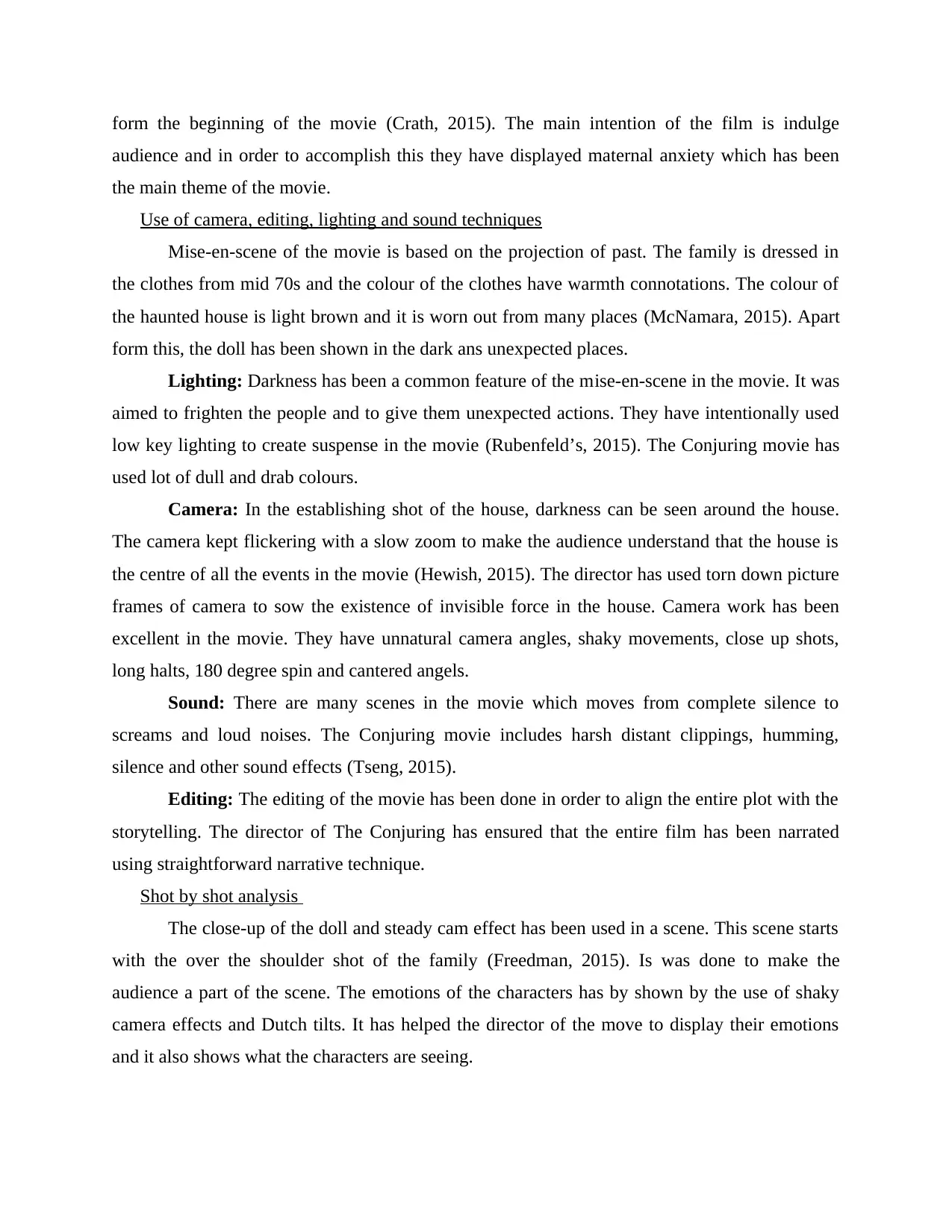
form the beginning of the movie (Crath, 2015). The main intention of the film is indulge
audience and in order to accomplish this they have displayed maternal anxiety which has been
the main theme of the movie.
Use of camera, editing, lighting and sound techniques
Mise-en-scene of the movie is based on the projection of past. The family is dressed in
the clothes from mid 70s and the colour of the clothes have warmth connotations. The colour of
the haunted house is light brown and it is worn out from many places (McNamara, 2015). Apart
form this, the doll has been shown in the dark ans unexpected places.
Lighting: Darkness has been a common feature of the mise-en-scene in the movie. It was
aimed to frighten the people and to give them unexpected actions. They have intentionally used
low key lighting to create suspense in the movie (Rubenfeld’s, 2015). The Conjuring movie has
used lot of dull and drab colours.
Camera: In the establishing shot of the house, darkness can be seen around the house.
The camera kept flickering with a slow zoom to make the audience understand that the house is
the centre of all the events in the movie (Hewish, 2015). The director has used torn down picture
frames of camera to sow the existence of invisible force in the house. Camera work has been
excellent in the movie. They have unnatural camera angles, shaky movements, close up shots,
long halts, 180 degree spin and cantered angels.
Sound: There are many scenes in the movie which moves from complete silence to
screams and loud noises. The Conjuring movie includes harsh distant clippings, humming,
silence and other sound effects (Tseng, 2015).
Editing: The editing of the movie has been done in order to align the entire plot with the
storytelling. The director of The Conjuring has ensured that the entire film has been narrated
using straightforward narrative technique.
Shot by shot analysis
The close-up of the doll and steady cam effect has been used in a scene. This scene starts
with the over the shoulder shot of the family (Freedman, 2015). Is was done to make the
audience a part of the scene. The emotions of the characters has by shown by the use of shaky
camera effects and Dutch tilts. It has helped the director of the move to display their emotions
and it also shows what the characters are seeing.
audience and in order to accomplish this they have displayed maternal anxiety which has been
the main theme of the movie.
Use of camera, editing, lighting and sound techniques
Mise-en-scene of the movie is based on the projection of past. The family is dressed in
the clothes from mid 70s and the colour of the clothes have warmth connotations. The colour of
the haunted house is light brown and it is worn out from many places (McNamara, 2015). Apart
form this, the doll has been shown in the dark ans unexpected places.
Lighting: Darkness has been a common feature of the mise-en-scene in the movie. It was
aimed to frighten the people and to give them unexpected actions. They have intentionally used
low key lighting to create suspense in the movie (Rubenfeld’s, 2015). The Conjuring movie has
used lot of dull and drab colours.
Camera: In the establishing shot of the house, darkness can be seen around the house.
The camera kept flickering with a slow zoom to make the audience understand that the house is
the centre of all the events in the movie (Hewish, 2015). The director has used torn down picture
frames of camera to sow the existence of invisible force in the house. Camera work has been
excellent in the movie. They have unnatural camera angles, shaky movements, close up shots,
long halts, 180 degree spin and cantered angels.
Sound: There are many scenes in the movie which moves from complete silence to
screams and loud noises. The Conjuring movie includes harsh distant clippings, humming,
silence and other sound effects (Tseng, 2015).
Editing: The editing of the movie has been done in order to align the entire plot with the
storytelling. The director of The Conjuring has ensured that the entire film has been narrated
using straightforward narrative technique.
Shot by shot analysis
The close-up of the doll and steady cam effect has been used in a scene. This scene starts
with the over the shoulder shot of the family (Freedman, 2015). Is was done to make the
audience a part of the scene. The emotions of the characters has by shown by the use of shaky
camera effects and Dutch tilts. It has helped the director of the move to display their emotions
and it also shows what the characters are seeing.
Paraphrase This Document
Need a fresh take? Get an instant paraphrase of this document with our AI Paraphraser
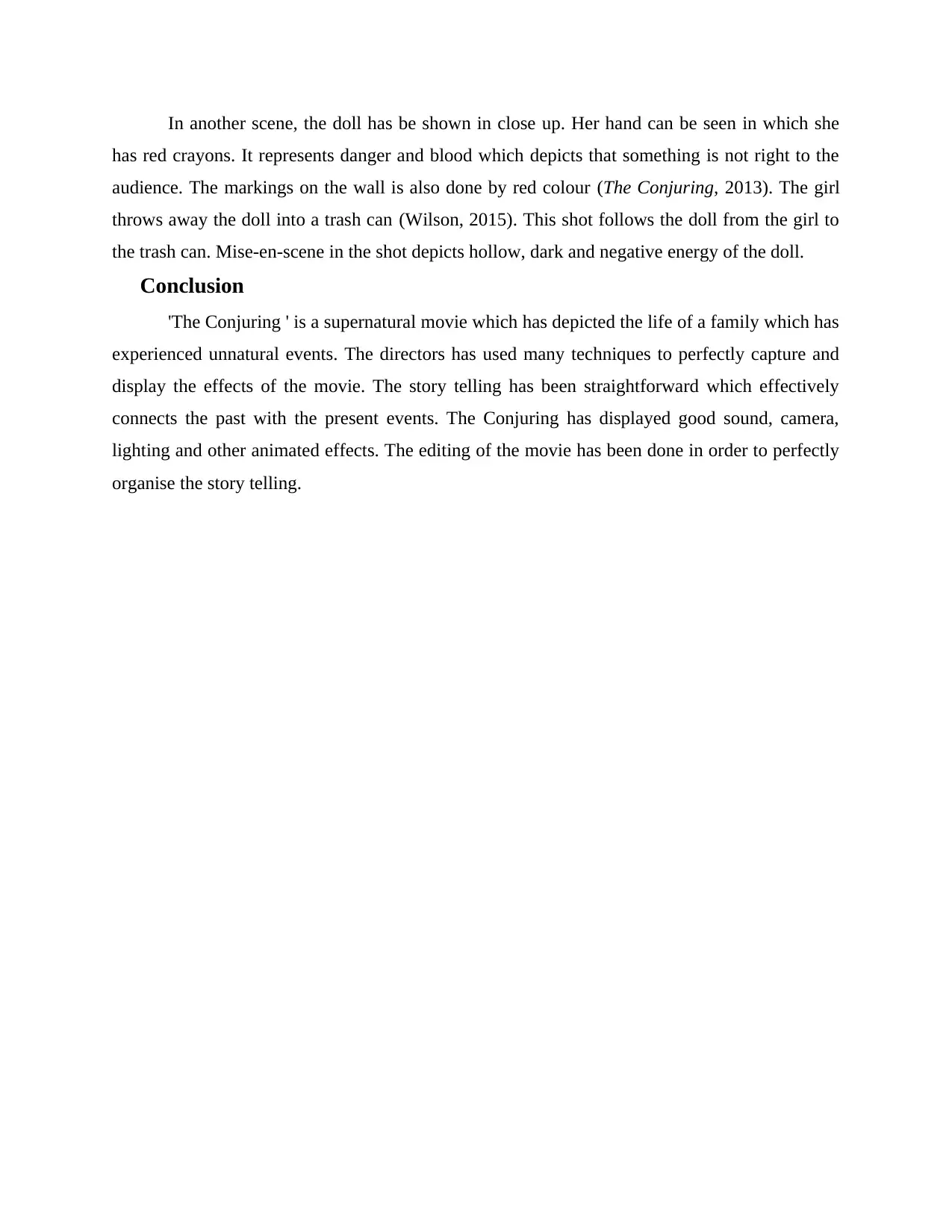
In another scene, the doll has be shown in close up. Her hand can be seen in which she
has red crayons. It represents danger and blood which depicts that something is not right to the
audience. The markings on the wall is also done by red colour (The Conjuring, 2013). The girl
throws away the doll into a trash can (Wilson, 2015). This shot follows the doll from the girl to
the trash can. Mise-en-scene in the shot depicts hollow, dark and negative energy of the doll.
Conclusion
'The Conjuring ' is a supernatural movie which has depicted the life of a family which has
experienced unnatural events. The directors has used many techniques to perfectly capture and
display the effects of the movie. The story telling has been straightforward which effectively
connects the past with the present events. The Conjuring has displayed good sound, camera,
lighting and other animated effects. The editing of the movie has been done in order to perfectly
organise the story telling.
has red crayons. It represents danger and blood which depicts that something is not right to the
audience. The markings on the wall is also done by red colour (The Conjuring, 2013). The girl
throws away the doll into a trash can (Wilson, 2015). This shot follows the doll from the girl to
the trash can. Mise-en-scene in the shot depicts hollow, dark and negative energy of the doll.
Conclusion
'The Conjuring ' is a supernatural movie which has depicted the life of a family which has
experienced unnatural events. The directors has used many techniques to perfectly capture and
display the effects of the movie. The story telling has been straightforward which effectively
connects the past with the present events. The Conjuring has displayed good sound, camera,
lighting and other animated effects. The editing of the movie has been done in order to perfectly
organise the story telling.
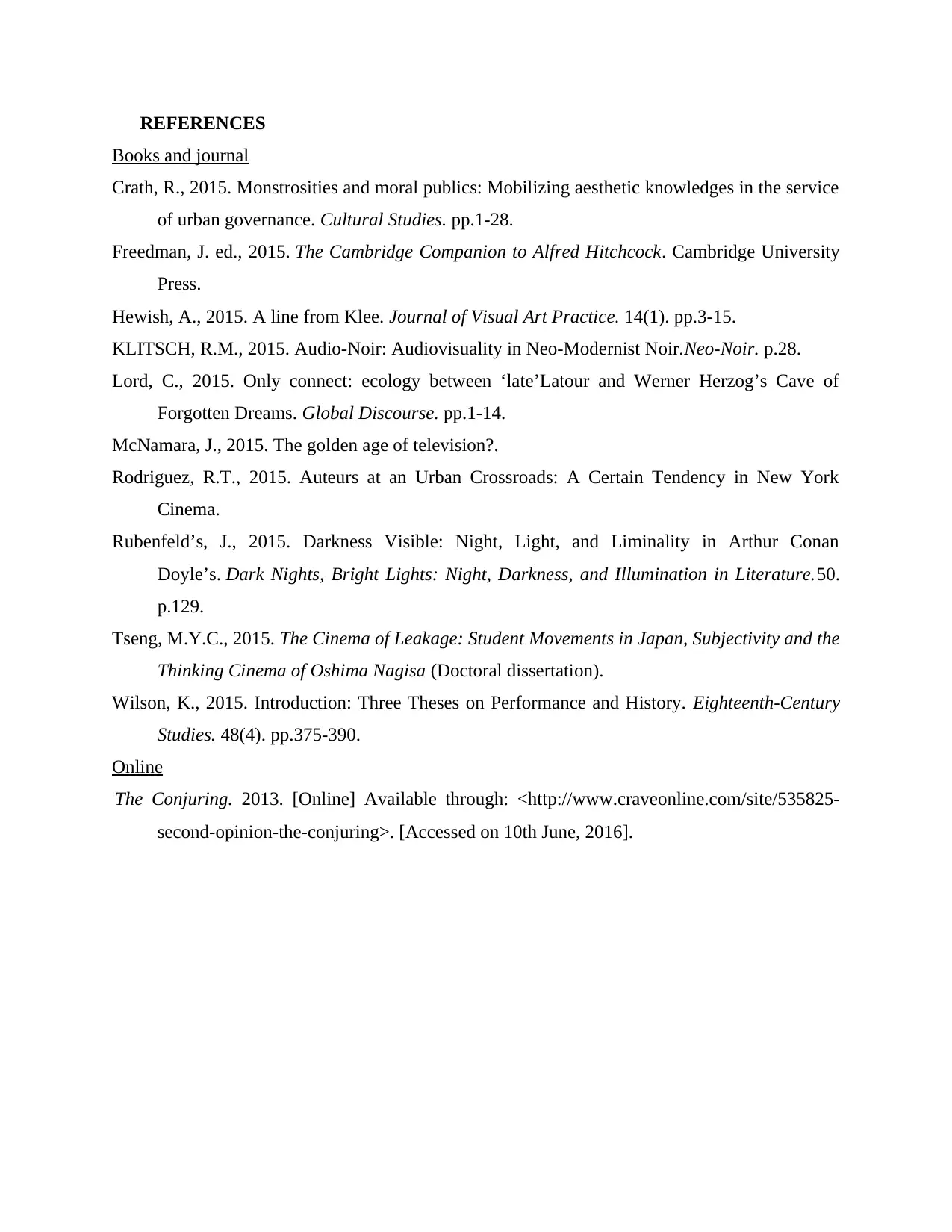
REFERENCES
Books and journal
Crath, R., 2015. Monstrosities and moral publics: Mobilizing aesthetic knowledges in the service
of urban governance. Cultural Studies. pp.1-28.
Freedman, J. ed., 2015. The Cambridge Companion to Alfred Hitchcock. Cambridge University
Press.
Hewish, A., 2015. A line from Klee. Journal of Visual Art Practice. 14(1). pp.3-15.
KLITSCH, R.M., 2015. Audio-Noir: Audiovisuality in Neo-Modernist Noir.Neo-Noir. p.28.
Lord, C., 2015. Only connect: ecology between ‘late’Latour and Werner Herzog’s Cave of
Forgotten Dreams. Global Discourse. pp.1-14.
McNamara, J., 2015. The golden age of television?.
Rodriguez, R.T., 2015. Auteurs at an Urban Crossroads: A Certain Tendency in New York
Cinema.
Rubenfeld’s, J., 2015. Darkness Visible: Night, Light, and Liminality in Arthur Conan
Doyle’s. Dark Nights, Bright Lights: Night, Darkness, and Illumination in Literature.50.
p.129.
Tseng, M.Y.C., 2015. The Cinema of Leakage: Student Movements in Japan, Subjectivity and the
Thinking Cinema of Oshima Nagisa (Doctoral dissertation).
Wilson, K., 2015. Introduction: Three Theses on Performance and History. Eighteenth-Century
Studies. 48(4). pp.375-390.
Online
The Conjuring. 2013. [Online] Available through: <http://www.craveonline.com/site/535825-
second-opinion-the-conjuring>. [Accessed on 10th June, 2016].
Books and journal
Crath, R., 2015. Monstrosities and moral publics: Mobilizing aesthetic knowledges in the service
of urban governance. Cultural Studies. pp.1-28.
Freedman, J. ed., 2015. The Cambridge Companion to Alfred Hitchcock. Cambridge University
Press.
Hewish, A., 2015. A line from Klee. Journal of Visual Art Practice. 14(1). pp.3-15.
KLITSCH, R.M., 2015. Audio-Noir: Audiovisuality in Neo-Modernist Noir.Neo-Noir. p.28.
Lord, C., 2015. Only connect: ecology between ‘late’Latour and Werner Herzog’s Cave of
Forgotten Dreams. Global Discourse. pp.1-14.
McNamara, J., 2015. The golden age of television?.
Rodriguez, R.T., 2015. Auteurs at an Urban Crossroads: A Certain Tendency in New York
Cinema.
Rubenfeld’s, J., 2015. Darkness Visible: Night, Light, and Liminality in Arthur Conan
Doyle’s. Dark Nights, Bright Lights: Night, Darkness, and Illumination in Literature.50.
p.129.
Tseng, M.Y.C., 2015. The Cinema of Leakage: Student Movements in Japan, Subjectivity and the
Thinking Cinema of Oshima Nagisa (Doctoral dissertation).
Wilson, K., 2015. Introduction: Three Theses on Performance and History. Eighteenth-Century
Studies. 48(4). pp.375-390.
Online
The Conjuring. 2013. [Online] Available through: <http://www.craveonline.com/site/535825-
second-opinion-the-conjuring>. [Accessed on 10th June, 2016].
⊘ This is a preview!⊘
Do you want full access?
Subscribe today to unlock all pages.

Trusted by 1+ million students worldwide
1 out of 6
Your All-in-One AI-Powered Toolkit for Academic Success.
+13062052269
info@desklib.com
Available 24*7 on WhatsApp / Email
![[object Object]](/_next/static/media/star-bottom.7253800d.svg)
Unlock your academic potential
Copyright © 2020–2025 A2Z Services. All Rights Reserved. Developed and managed by ZUCOL.
